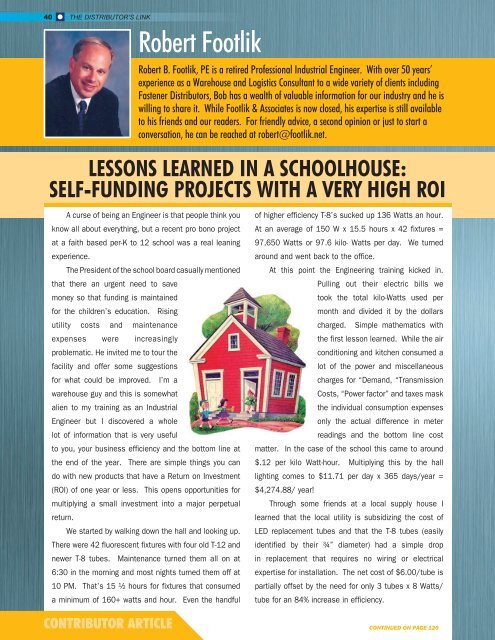SPRING 2017
Distributor's Link Magazine Spring Issue 2017 / Vol 40 No2
Distributor's Link Magazine Spring Issue 2017 / Vol 40 No2
Create successful ePaper yourself
Turn your PDF publications into a flip-book with our unique Google optimized e-Paper software.
40<br />
THE DISTRIBUTOR’S LINK<br />
Robert Footlik<br />
Robert B. Footlik, PE is a retired Professional Industrial Engineer. With over 50 years’<br />
experience as a Warehouse and Logistics Consultant to a wide variety of clients including<br />
Fastener Distributors, Bob has a wealth of valuable information for our industry and he is<br />
willing to share it. While Footlik & Associates is now closed, his expertise is still available<br />
to his friends and our readers. For friendly advice, a second opinion or just to start a<br />
conversation, he can be reached at robert@footlik.net.<br />
LESSONS LEARNED IN A SCHOOLHOUSE:<br />
SELF-FUNDING PROJECTS WITH A VERY HIGH ROI<br />
A curse of being an Engineer is that people think you<br />
know all about everything, but a recent pro bono project<br />
at a faith based per-K to 12 school was a real leaning<br />
experience.<br />
The President of the school board casually mentioned<br />
that there an urgent need to save<br />
money so that funding is maintained<br />
for the children’s education. Rising<br />
utility costs and maintenance<br />
expenses were increasingly<br />
problematic. He invited me to tour the<br />
facility and offer some suggestions<br />
for what could be improved. I’m a<br />
warehouse guy and this is somewhat<br />
alien to my training as an Industrial<br />
Engineer but I discovered a whole<br />
lot of information that is very useful<br />
to you, your business efficiency and the bottom line at<br />
the end of the year. There are simple things you can<br />
do with new products that have a Return on Investment<br />
(ROI) of one year or less. This opens opportunities for<br />
multiplying a small investment into a major perpetual<br />
return.<br />
We started by walking down the hall and looking up.<br />
There were 42 fluorescent fixtures with four old T-12 and<br />
newer T-8 tubes. Maintenance turned them all on at<br />
6:30 in the morning and most nights turned them off at<br />
10 PM. That’s 15 ½ hours for fixtures that consumed<br />
a minimum of 160+ watts and hour. Even the handful<br />
CONTRIBUTOR ARTICLE<br />
of higher efficiency T-8’s sucked up 136 Watts an hour.<br />
At an average of 150 W x 15.5 hours x 42 fixtures =<br />
97,650 Watts or 97.6 kilo- Watts per day. We turned<br />
around and went back to the office.<br />
At this point the Engineering training kicked in.<br />
Pulling out their electric bills we<br />
took the total kilo-Watts used per<br />
month and divided it by the dollars<br />
charged. Simple mathematics with<br />
the first lesson learned. While the air<br />
conditioning and kitchen consumed a<br />
lot of the power and miscellaneous<br />
charges for “Demand, “Transmission<br />
Costs, “Power factor” and taxes mask<br />
the individual consumption expenses<br />
only the actual difference in meter<br />
readings and the bottom line cost<br />
matter. In the case of the school this came to around<br />
$.12 per kilo Watt-hour. Multiplying this by the hall<br />
lighting comes to $11.71 per day x 365 days/year =<br />
$4,274.88/ year!<br />
Through some friends at a local supply house I<br />
learned that the local utility is subsidizing the cost of<br />
LED replacement tubes and that the T-8 tubes (easily<br />
identified by their ¾” diameter) had a simple drop<br />
in replacement that requires no wiring or electrical<br />
expertise for installation. The net cost of $6.00/tube is<br />
partially offset by the need for only 3 tubes x 8 Watts/<br />
tube for an 84% increase in efficiency.<br />
CONTINUED ON PAGE 120

















